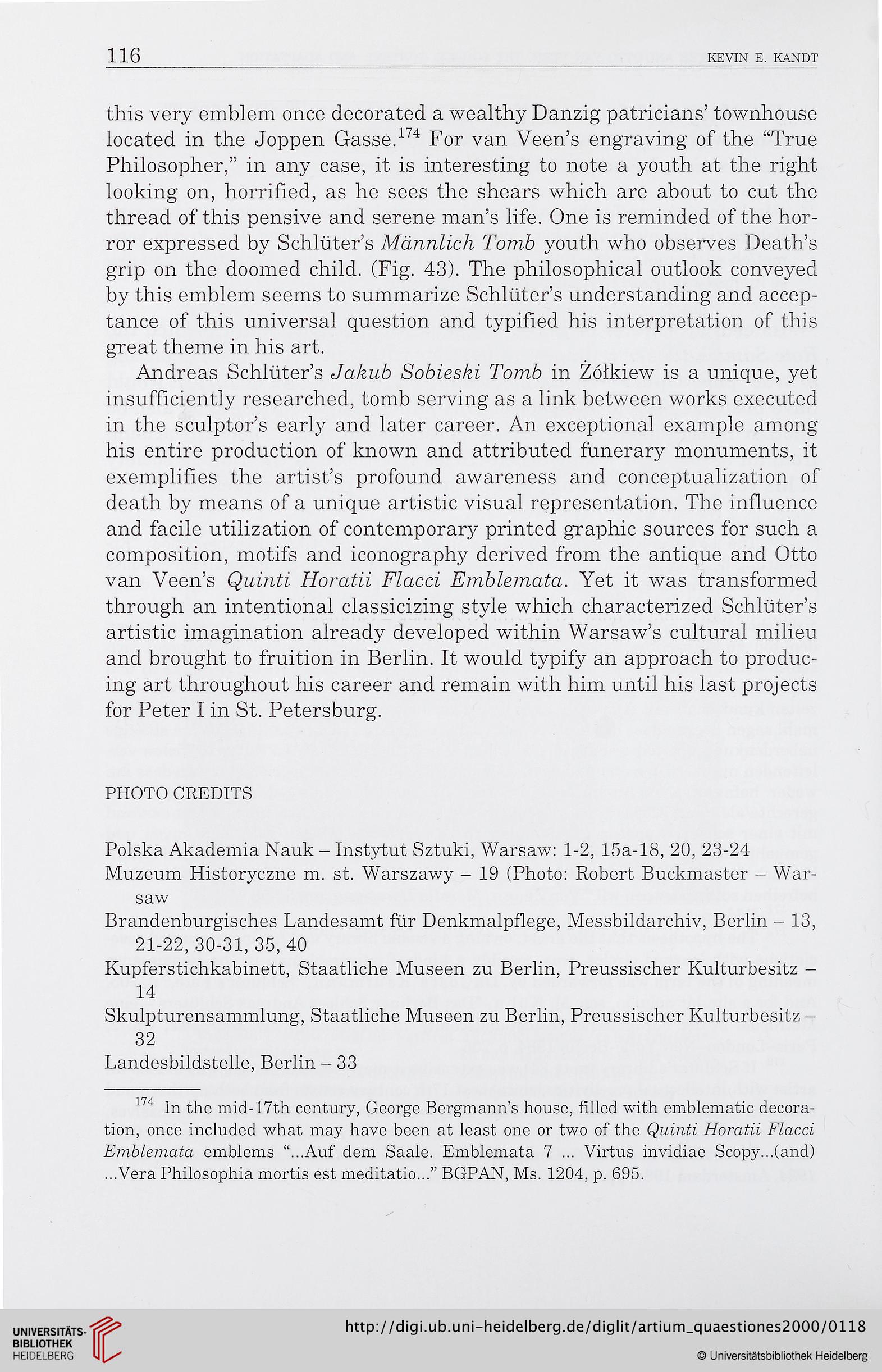116
KEVIN E. KANDT
this very emblem once decorated a wealthy Danzig patricians’ townhouse
located in the Joppen Gasse.174 For van Veen’s engraving of the “True
Philosopher,” in any case, it is interesting to note a youth at the right
looking on, horrifïed, as he sees the shears which are about to eut the
thread of this pensive and serene man’s life. One is reminded of the hor-
ror expressed by Schlüter’s Mdnnlich Tomb youth who observes Death’s
grip on the doomed child. (Fig. 43). The philosophical outlook conveyed
by this emblem seems to summarize Schlüter’s understanding and accep-
tance of this universal question and typifïed his interprétation of this
great theme in his art.
Andréas Schlüter’s Jakub Sobieski Tomb in Zôlkiew is a unique, yet
insuffîciently researched, tomb serving as a link between works executed
in the sculptor’s early and later career. An exceptional example among
his entire production of known and attributed funerary monuments, it
exemplifies the artist’s profound awareness and conceptualization of
death by means of a unique artistic visual représentation. The influence
and facile utilization of contemporary printed graphie sources for such a
composition, motifs and iconography derived from the antique and Otto
van Veen’s Quinti Horatii Flacci Emblemata. Yet it was transformed
through an intentional classicizing style which characterized Schlüter’s
artistic imagination already developed within Warsaw’s cultural milieu
and brought to fruition in Berlin. It would typify an approach to produc-
ing art throughout his career and remain with him until his last projects
for Peter I in St. Petersburg.
PHOTO CREDITS
Polska Akademia Nauk- Instytut Sztuki, Warsaw: 1-2, 15a-18, 20, 23-24
Muzeum Historyczne m. st. Warszawy - 19 (Photo: Robert Buckmaster - War-
saw
Brandenburgisches Landesamt fur Denkmalpflege, Messbildarchiv, Berlin - 13,
21-22, 30-31, 35, 40
Kupferstichkabinett, Staatliche Museen zu Berlin, Preussischer Kulturbesitz -
14
Skulpturensammlung, Staatliche Museen zu Berlin, Preussischer Kulturbesitz -
32
Landesbildstelle, Berlin - 33
174 In the mid-17th century, George Bergmann’s house, fïlled with emblematic décora-
tion, once included what may hâve been at least one or two of the Quinti Horatii Flacci
Emblemata emblems “...Auf dem Saale. Emblemata 7 ... Virtus invidiae Scopy...(and)
...Vera Philosophia mortis est meditatio...” BGPAN, Ms. 1204, p. 695.
KEVIN E. KANDT
this very emblem once decorated a wealthy Danzig patricians’ townhouse
located in the Joppen Gasse.174 For van Veen’s engraving of the “True
Philosopher,” in any case, it is interesting to note a youth at the right
looking on, horrifïed, as he sees the shears which are about to eut the
thread of this pensive and serene man’s life. One is reminded of the hor-
ror expressed by Schlüter’s Mdnnlich Tomb youth who observes Death’s
grip on the doomed child. (Fig. 43). The philosophical outlook conveyed
by this emblem seems to summarize Schlüter’s understanding and accep-
tance of this universal question and typifïed his interprétation of this
great theme in his art.
Andréas Schlüter’s Jakub Sobieski Tomb in Zôlkiew is a unique, yet
insuffîciently researched, tomb serving as a link between works executed
in the sculptor’s early and later career. An exceptional example among
his entire production of known and attributed funerary monuments, it
exemplifies the artist’s profound awareness and conceptualization of
death by means of a unique artistic visual représentation. The influence
and facile utilization of contemporary printed graphie sources for such a
composition, motifs and iconography derived from the antique and Otto
van Veen’s Quinti Horatii Flacci Emblemata. Yet it was transformed
through an intentional classicizing style which characterized Schlüter’s
artistic imagination already developed within Warsaw’s cultural milieu
and brought to fruition in Berlin. It would typify an approach to produc-
ing art throughout his career and remain with him until his last projects
for Peter I in St. Petersburg.
PHOTO CREDITS
Polska Akademia Nauk- Instytut Sztuki, Warsaw: 1-2, 15a-18, 20, 23-24
Muzeum Historyczne m. st. Warszawy - 19 (Photo: Robert Buckmaster - War-
saw
Brandenburgisches Landesamt fur Denkmalpflege, Messbildarchiv, Berlin - 13,
21-22, 30-31, 35, 40
Kupferstichkabinett, Staatliche Museen zu Berlin, Preussischer Kulturbesitz -
14
Skulpturensammlung, Staatliche Museen zu Berlin, Preussischer Kulturbesitz -
32
Landesbildstelle, Berlin - 33
174 In the mid-17th century, George Bergmann’s house, fïlled with emblematic décora-
tion, once included what may hâve been at least one or two of the Quinti Horatii Flacci
Emblemata emblems “...Auf dem Saale. Emblemata 7 ... Virtus invidiae Scopy...(and)
...Vera Philosophia mortis est meditatio...” BGPAN, Ms. 1204, p. 695.




